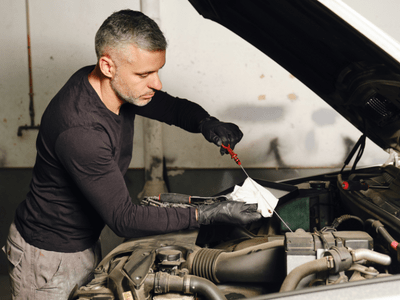
First off, what is considered long term storage of a car? There’s no set amount of time where “storage” becomes “long term storage,” but experts generally agree that there are precautions that car owners should take if they don’t plan on driving a car for over a month. The longer a car goes without use, the greater the chance that something goes wrong when it is time to use it again.
If you’re looking to minimise the risk of damage to your car – whether for a period of months or even longer – we can help. Our automotive experts have put together the following guide on how to store a car long term!
The first step toward successful long term vehicle storage is finding the ideal place. Moisture, temperature changes and extreme heat or cold can damage a car in storage, so you must find somewhere protected from those elements - and our vehicle storage service for businesses does exactly that. For the long term, indoor car storage is preferable. A heated garage is great, and an unheated garage can be made to work.
In addition to the environmental conditions, you must consider security. A locked garage is a good option for this. If you don’t have access to a garage and are willing to pay for your car to be looked after, consider a long term car storage facility. Some facilities even offer services to address other items on this list, such as keeping the battery topped up.
If you’re planning on storing your car for a shorter period, such as a few weeks, or can visit it and drive it regularly to keep it from seizing up, consider vehicle storage at your local Access Self Storage branch. Vehicle storage at our facilities is a competitively priced outdoor storage option, locked behind a fence and gate and watched over by CCTV.
There are a lot of steps to consider when working out how to store a car long term and, of course, significant periods between visits to the car. This means it’s easy to forget what you’ve done and planned to do.
The solution is to make a plan – it doesn’t need to be complicated – and update it with the date whenever you complete a task. If you’re worried you’ll lose a paper plan, try typing it out on the notes app on your smartphone – that way, you’ll always have it with you. Another benefit to the plan is that it becomes a to-do list when you bring your car back into service, ensuring that you haven’t forgotten any crucial steps.
Going on a road trip? Check out our list of top car packing hacks and tips.
When it comes to how to prepare your car for long term storage, cleaning may seem like a surprising step. However, it’s not about how the car looks. Instead, it’s about the combined impact of dirt and time. While dirt on a car’s paint job won’t do damage in normal conditions, it can begin to damage the paint when left for months at a time. Tiny particles on the paint, like bits of asphalt, can also provide a place for rust to take hold, so it’s worth cleaning the car even if it doesn’t look dirty.
You also need to clean the inside of your car. You’ll thank yourself when you get back in the driver's seat for a start, but you also need to make sure you haven’t left anything that could spoil in the car – that would be a nasty surprise! A clean interior also has a lower chance of developing issues like mould.
The next trick to long term car storage is to keep the petrol tank from rusting by filling it before the vehicle goes into storage. Be aware that petrol spoils if you leave it for long enough.
How long petrol lasts depends on the temperature – it could last for up to six months at 20 degrees, but that lifetime halves to three months at 30 degrees. If you leave your car for longer than the lifespan of the petrol, you need to be prepared to drain the tank and fill it with fresh petrol before the car is ready to drive again.
You can keep the fuel fresh for longer with a product called “fuel stabiliser,” which you add to a full tank of petrol, although there is debate among car enthusiasts about whether stabilised petrol does damage to your engine.
A car cover is essential whether you’re keeping your car indoors or outdoors. It keeps moisture and dust off the car and deters animals from perching on it – or worse, trying to get into it.
You should store your car with the windows rolled up and the doors, bonnet and hood locked in the closed position. It would be best to ensure that any potential ways into the car, such as the tailpipe, are blocked off. This will keep small pests like rats and mice out. A rag should do but note this down on your storage plan, so you remember to remove it before you restart the car.
If you’re looking for advice on how to store a motorcycle correctly, we’ve got the perfect guide for you!
Rust is one of the biggest challenges when it comes to the question of how to store a car long term. Even in mild, low-humidity conditions, it sometimes finds a way to creep in. If humidity is a risk in your storage area, consider using some “disposable dehumidifiers” – small tubs that slowly pull water from the air. These will need to be changed every three to six weeks.
Your best chance of fighting off the rust is to thoroughly lubricate exposed, moving parts of the car, such as the door hinges. Be sure to use an appropriate lubricant for each component, as the wrong product could do more harm than good! If you’re worried about rust getting to the paint job, apply a layer of wax after cleaning your car. This makes it harder for rust to spread.
Most fluids should be kept topped up for long term car storage. The anti-freeze tank, like the fuel, should be kept topped up, especially if your vehicle requires power steering or transmission fluid.
To some, the most important fluid is engine oil. This oil picks up corrosive contaminants while the engine runs, so leaving “dirty” oil in a car before sending it to storage significantly increases the risk of damage. Fortunately, an oil change ensures that the oil is free of contamination.

A common mistake is treating long-term car storage just like parking: drive your car to the storage site, pop on the parking brake, and walk away. Unfortunately, drivers who do this often return to a car with its brakes locked up. Instead of applying the brake, use purpose-made “chocks” – triangles of tough material – to keep your car in one place while you store it.
Whilst preparing your car for long term storage, take a look at our top tips for a garage makeover.
Another long-term storage risk is that the car's weight deforms the tyres. This is particularly common in vehicles that have been stored for more than six months. It’s unsafe to drive a car with warped tyres, so it’s important to address this before sending the car to storage. You can rotate the tires monthly or, ideally, elevate them with jack stands.
Perhaps the most common question people ask when considering how to store a car long term is, “should I disconnect the battery when storing my car?” The answer is yes: if you don’t plan on starting your car for a month or more, you should disconnect the battery. Before that, make sure the battery is topped up by going for a drive – a battery with a low charge will age faster than a full battery. Disconnect the negative terminal first, followed by the positive one.
Alternatively, you could run the car’s engine for 15 minutes every two weeks to keep the battery topped up. Ideally, you would even take it for a short drive to give all the other car parts a chance to shake off the cobwebs. You do not need to disconnect the battery if you can do this. A third option is to use a “smart charger” or “trickle charger.” This device measures the battery’s condition and slowly supplies power to keep it topped up.
That’s it for our guide on how to store a car long term.
To learn more about our car storage options and get a quote, contact your local Access Self Storage branch.